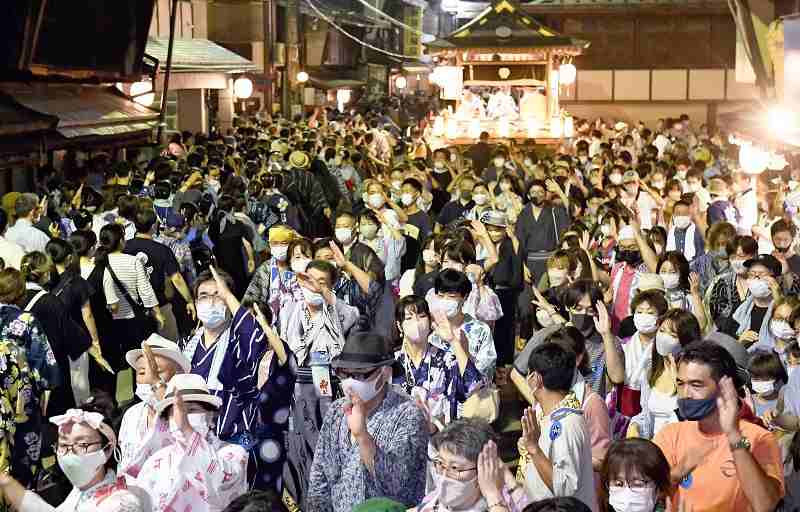Traditional Japanese dances likely to be registered as intangible cultural heritage by UNESCO

The Nishimonai Bon Odori in Ugo, Akita Prefecture, in August
17:16 JST, November 1, 2022
Furyu odori, a collection of 41 traditional Japanese dances, is expected to be registered as an intangible cultural heritage by UNESCO.
The Cultural Affairs Agency announced Tuesday that UNESCO’s evaluation body has recommended its registration. The official decision is expected to be made at an intergovernmental committee meeting to be held in Rabat, Morocco, from Nov. 28.
Furyu odori are performance folk art featuring elaborate costumes and props, with people dancing to the accompaniment of singing and musical instruments such as flutes. A total of 41 such traditional dances from 24 prefectures are expected to be registered.
Among the dances are Bon Odori and Nembutsu Odori, including the Gujo Odori in Gifu Prefecture for which dancers gather from all over Japan. The Gujo Odori is known for its all-night performances with many rows of dancers surrounding a float.

The Gujo Odori in Gujo, Gifu Prefecture, in August
Participants in the Nishimonai Bon Odori in Ugo, Akita Prefecture, wear brightly colored costumes and straw hats, and dance in a flowing style. The Rokusai Nembutsu has been handed down in various parts of Kyoto, and the Ayako Odori in Manno, Kagawa Prefecture, is an event to pray for rain associated with the Buddhist monk Kukai.
Registration as an intangible cultural heritage requires the existence of a preservation system in the nation in question. Bon Odori are practiced throughout Japan, but the list was narrowed down to 41 dances that have been designated as nationally important intangible folk cultural assets and which local preservation societies are working actively to safeguard.
The Chakkirako dance in Miura, Kanagawa Prefecture, was registered as a UNESCO intangible cultural heritage in 2009. The government added 40 new dances and proposed grouping all 41 as furyu odori.
Many of the furyu odori date to the Edo period (1603-1867) or earlier, and developed in various regions as offerings to the dead or events to pray for good harvests and ward off bad luck.
The dances have been handed down through the ages, changing with shrinking populations, low birth rates and other factors.
Japan is prone to natural disasters, and the proposal for registration emphasized the cultural and social significance of the dances as a spiritual foundation for the revival of disaster-stricken areas.
Japan currently has 22 registered intangible cultural heritages, including noh, kabuki, washoku Japanese food, washi Japanese paper and the Chakkirako dance.
"Society" POPULAR ARTICLE
-

M4.9 Earthquake Hits Tokyo, Neighboring Prefectures
-

Israeli Tourists Refused Accommodation at Hotel in Japan’s Nagano Pref., Prompting Protest by Israeli Embassy and Probe by Prefecture
-

M7.5 Earthquake Hits Northern Japan; Tsunami Waves Observed in Hokkaido, Aomori and Iwate Prefectures
-

Tsukiji Market Urges Tourists to Avoid Visiting in Year-End
-

M5.7 Earthquake Hits Japan’s Kumamoto Pref., Measuring Upper 5 Intensity, No Tsunami Expected
JN ACCESS RANKING
-

Tokyo Economic Security Forum to Hold Inaugural Meeting Amid Tense Global Environment
-

Keidanren Chairman Yoshinobu Tsutsui Visits Kashiwazaki-Kariwa Nuclear Power Plant; Inspects New Emergency Safety System
-

Imports of Rare Earths from China Facing Delays, May Be Caused by Deterioration of Japan-China Relations
-

University of Tokyo Professor Discusses Japanese Economic Security in Interview Ahead of Forum
-

Japan Pulls out of Vietnam Nuclear Project, Complicating Hanoi’s Power Plans






















